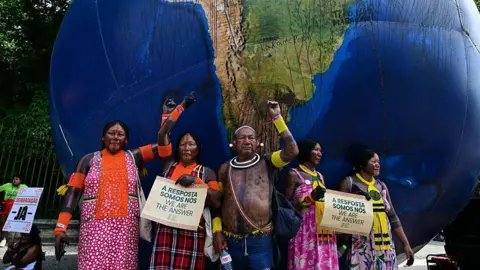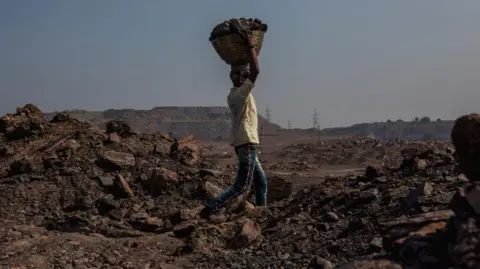Naveen Singh KhadkaEnvironment correspondent for the BBC World Service
 Getty Images
Getty ImagesAt this year's UN climate summit (COP30) in Belem, Brazil, all eyes are on India, the world's third-largest emitter of carbon dioxide.
India has yet to submit a key climate plan that countries must implement every five years, even as international assessments have found India's climate action to be “worryingly inadequate.” Delhi says the opposite.
Each country party to the United Nations Framework Convention on Climate Change (UNFCCC)'s updated plan, known as Nationally Determined Contributions (NDC), is expected to have more ambitious targets for cutting carbon emissions as the world has failed to achieve the required level of reductions to avoid dangerous global warming.
So far, about 120 of the 196 UNFCCC member countries have submitted their updated plans, and India is among the remaining.
The Paris climate agreement, signed in 2015, aims to limit the rise in average global temperatures to well below 2°C and aim for a rise of 1.5°C to prevent dramatic climate change.
The United Nations Environment Program (UNEP) says that by 2035 annual emissions will have to be reduced by 35% and 55% compared to 2019 to meet the goals of the Paris Agreement.
But emissions have continued to rise almost every year since then, and climate plans presented to the UNFCCC until November 10 show that emissions reductions will be only about 12% by 2035 – and that too if countries fully implement their policies.
UNEP warns that current emissions policies put the world on track to warm by 2.8°C this century, highlighting the need for much more ambitious carbon emissions reduction targets.
The first deadline for the updated climate plan (NDC3) was February, but it was extended until September because more than 90% of member countries failed to meet it.
All eyes have been on major emitters such as China, India and the European Union as US President Donald Trump once again announced his country's withdrawal from the Paris Agreement, leaving the world wondering whether other major emitters will step up to fill the gap.
But many countries also missed the September deadline. While some began presenting their plans before COP30, others were expected to do so during the climate meeting in Belém.
Some did so, but India kept the world guessing until Environment Minister Bhupender Yadav, who led the country's delegation to Belem, told the media this week that Delhi would only present its plan by the end of December.
So why has India delayed introducing its climate plan when it could mean bad press during COP30?
 Getty Images
Getty ImagesWhile Delhi has not explained its position, it appears keen to highlight a view shared by many developing countries: rich countries have a historic responsibility to cut emissions and provide much more financial support to the developing world.
A week before the start of COP30, Yadav wrote a piece in the Economic Times stating that “global climate progress cannot be achieved through endless discussions alone.”
“For too long, the world has been caught in a cycle of negotiations while the planet's distress signal grows louder. While dialogue is important, action is necessary,” he wrote.
Bye India's statement at COP30Yadav seemed to expand on this argument.
“Developed countries must reach net-zero emissions well ahead of current target dates and provide new, additional and concessional climate finance on the scale of trillions, not billions,” he said.
Indian officials, like many developing-world negotiators, argue that their updated climate plans with more ambitious carbon reduction targets will make no difference unless they receive financial and technological support from developed countries.
The Paris climate agreement requires developed countries to provide financial support to the developing world, but this remains a controversial issue.
The latest congress in Baku, Azerbaijan, saw an angry reaction from the developing world when developed countries said they would provide $300 billion (£229 billion) annually in climate finance by 2035, while poor countries demanded more than $1 trillion.
Developing countries also say there is a lack of clarity and transparency about how the $300 billion will be provided, and that developed countries are pushing for private financing that saddles poor countries with loans.
Meanwhile, some developed countries argue that fast-growing economies such as China and India should also contribute to the global climate finance bank.
“The best way to make sure Europe can handle this is [the climate finance it has been providing] is to invite others who have the opportunity to do so… to contribute,” said Wopke Hoekstra, European Commission climate commissioner, at a press conference at COP30.
Without naming any country, he said that in many cases (eg other countries) GDP per capita is much higher than the vast majority of European member states.
 Getty Images
Getty ImagesIndia says it should not press for a more ambitious climate plan because it has already met a key commitment to provide 50% of its installed electricity capacity from non-fossil fuels several years ahead of the 2030 deadline.
Global assessments praise this, but also note other problems.
Climate Action Tracker, an independent science project that monitors government actions to combat climate change and measures their compliance with the globally agreed upon Paris Agreement, rated India's climate goals and actions as “extremely insufficient“.
It noted that coal's share of India's total power generation remains around 75%, while it needs to fall to at least 19% to align the country's climate action with the global goal of limiting temperature rise to 1.5°C.
Another report released at COP30 also highlighted India's over-reliance on coal.
IN Climate Change Performance IndexIndia has dropped 13 places over the past year to rank 23rd out of 63 countries and the EU, according to environmental think tank GermanWatch.
“India's national path remains linked to coal and there is no national timetable for exiting coal, while new coal blocks continue to be auctioned,” the think tank said in its report.
According to a recent UN Emissions Gap ReportIndia saw the highest year-on-year growth in greenhouse gas emissions in 2024, followed by China and Indonesia.
But China, the world's biggest emitter of carbon dioxide and typically India's ally in climate talks to antagonize developed countries, has already unveiled its updated climate plan.
And now COP30 is also discussing whether to announce a roadmap to transition the world away from fossil fuels.
It remains to be seen whether the criticism surrounding India's coal dependence will affect its updated climate plan, which it has committed to unveiling by the end of this year.









